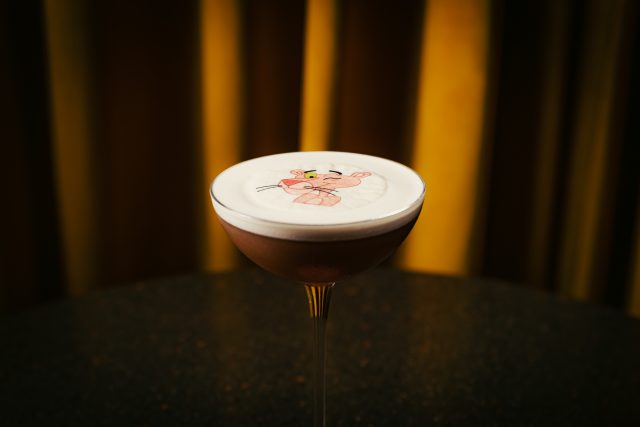This website uses cookies so that we can provide you with the best user experience possible. Cookie information is stored in your browser and performs functions such as recognising you when you return to our website and helping our team to understand which sections of the website you find most interesting and useful.
What to drink at Seed Library
Louis Thomas gets to grips with the eclectic new cocktail menu at Seed Library in Shoreditch, featuring ingredients as varied as soured green peas and a rapidly-aged cup of tea.

Stepping off at 100 Shoreditch High Street and heading downstairs and further down, you find Seed Library, a celebration of browns, reds and oranges that proves that 1970s-esque stylings still have a place in the world.
But, while the decor might be a delightful throwback, brilliantly described by team member Matthew Birks as “Austin Powers meets your nan’s front room”, the new cocktail menu is innovative to the extreme, the result of four months of development and years of collective experience from the team.
“We’re trying to step out of our comfort zone,” explained founder Ryan Chetiyawardana to the drinks business. “We want to explore how you can transform different ingredients, rather than having them as the star player.”
“We remain very curious about the whole world of food and drink,” he suggested. “It’s always got to be purposeful, not just for its own sake.”
That curiosity can clearly be seen in the cocktail prep room, with bags, boxes and bottles brimming with various ingredients, ranging from the laboriously hand-rolled cardamom leaves used in the Hand-Rolled Spritz, to the Noma Project’s wild rose vinegar (for the Project Fizz), and even a couple of jars of mead fermenting away. This is certainly a departure from my own cocktail cabinet.
But the proof of the mixology is in the sipping.

Moonlit Gimlet
Whereas Seed Library’s Coriander Seed Gimlet has been on the menu since it opened in 2022, and remains so, the new addition offers something even further away from the Gimlet one might expect, but it is no less delicious for it.
The ingredient that stands out most is the inclusion of soured green peas. However, this isn’t the bartenders taking the p – some versions of poitín, an Irish moonshine, are made using the legumes, and the peas are acidified, but not to the point that they are vinegary, lending a sweetness and sourness that is rather reminiscent of lime. From a colour perspective, it’s also on the money.
Unlike the Coriander Seed Gimlet, which uses the traditional spirit of gin, the Moonlit Gimlet makes use of Patrón Tequila. It was explained by Birks that the choice of an agave-based spirit was due to the “green, vegetal notes” complementing the pea flavour nicely, and indeed they do, though it does not fall foul of the crime (or virtue, depending on your perspective) of tasting too strongly of Tequila. The touch of elderflower at the end prevents things from tasting overly of chlorophyll.
Master Stock Plus

The contribution of Roman bartender Alessandro Todini to the menu, the Master Stock Plus is, for me, the drink that best matches the decor, thanks to its luminous orange hue, with a slick of brown on top.
Consisting of Maker’s Mark Bourbon, orange aperitif (or should that be aperitivo?), cacao and, the component which reeled me in, mushroom lou mei. The latter, which is a Cantonese term used for dishes braised in a master stock (according to Wikipedia), is in this case a stock made of liquorice, cocoa nibs and dried mushrooms, including shiitake, porcini, oyster and chestnut.
Smoky, slightly sweet, and also very savoury, perhaps it won’t be for everyone, but it’s very much for me – and, though the mushroom does lend, and I hate myself for using the word, umami, it doesn’t taste like a tin of Campbell’s soup.
Pink Panther

This was the cocktail that intrigued me the most, mainly because of one key ingredient – rapid aged cuppa.
Without wanting to give away too many secrets of how this mystical component is created, it is effectively what happens when you take Yorkshire Tea, mix it with Jersey milk and a lot of sugar, and leave it under sous vide for a stint of time. It is a similar process to the production of black garlic. Supposedly, a former bartender was in the habit of using this technique on all sorts, including Guinness and black fruit, but the builder’s brew has proven to be something really rather fascinating.
Tasting the rapid-aged cuppa on its own is reminiscent of necking some kind of malted milk biscuit beverage – given the sugar content, about 50% by weight, it is perhaps for the best that this is not available on supermarket shelves yet, though it would certainly be a delicious public health menace. The tannins from the tea don’t exactly prevent it from being cloying, but it is not an ingredient intended to be shotted (though I would not be opposed to the idea).
“It doesn’t just taste like we’ve dropped something weird into the drink,” reassured Chetiyawardana.
Indeed, in the Pink Panther, it adds a creamy texture and chocolatey aroma that works wonders with the other ingredients (Lost Explorer mezcal, soka, raspberry, and citrus) – it certainly doesn’t look pink, but has the tartness that one might expect from a regular Pink Panther. Psychologically, it takes a few sips to wrap your head around a brown, creamy drink tasting that fruity, but I think this may have been my favourite of the cocktails tasted, and I’m not even a big tea drinker.
Megamix Sazerac
The Sazerac is a cocktail with a legendary reputation, with the Absinthe rinse of the glass in this New Orleans classic usually the precursor to a night to remember, or to forget.
But, in keeping with the rest of this menu, the Megamix Sazerac defies expectations. The drinks takes inspiration from the bouba/kiki effect, which involves the sounds people association with certain shapes (‘kiki’ making one think of something more angular, ‘bouba’ of something more rounded).
The angular aspect of the Megamix Sazerac is lent by the inclusion of Talisker 10 Scotch whisky. The addition of creme de beach, Seed Library’s riff on crème de peche, but with tropical fruits including pineapple, guava and passionfruit, softens the edges. The two other ingredients, beeswax vinegar and absinthe mallow, themselves embody the bouba/kiki divide, bringing both harshness and smoothness. I certainly wouldn’t start with it, but it’s great for the tail end of the evening, and any creases are further ironed out when it is accompanied by a bowl of potato smiles.
Is it a gimmick?
In truth, as you may have gathered, I was rather impressed by Seed Library, not just for the quality of its drinks, but also the prices – with most of the cocktails on the new menu sitting around the £14-15 mark, aside from the Sazerac which comes in at a still reasonable £16. Given the hours put into each component, this certainly shames the prices at other cocktail bars further west in London.
While the inclusion of weird and wonderful ingredients might seem gimmicky, they do genuinely add something, and also, always a plus in any bar, provide a conversation starter – I’ve never spoken so much about tea before.
I also appreciated that the drinks are allowed to speak for themselves – there’s a bit of patter about what they’re made from, and the obvious theatre of the bartenders wielding their Koriko shakers, but it doesn’t go overboard.
Chetiyawardana summarised this style as finding beauty “in a range of things”: “It doesn’t need to be covered in candy floss and have smoke coming out of it to be beautiful. Everything has to be there for the drinker’s enjoyment.”
Related reading:

